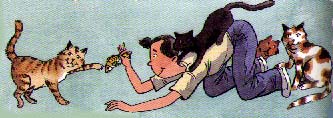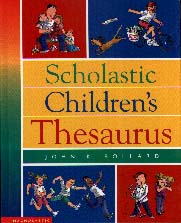|
________________
CM . . . .
Volume V Number 10 . . . . January 15, 1999
excerpt: Note that clothes is a plural noun and always takes a plural verb: My clothes are on fire! Clothing is a collective noun. It may refer to all of the clothes you are wearing, but it always takes a singular verb: Warm clothing is necessary in the winter. Apparel and attire are also collective nouns that take a singular verb. In this entry, only garment can be both singular and plural.  Designed
for young developing writers, this thesaurus contains more that 500 alphabetic
entries. Green headwords, followed by the part of speech, are printed in
uppercase. Synonyms in blue typeface and their definitions are arranged on the
left side of the page; sample sentences, modeling typical usage of the word,
are arranged on the right-hand side. The synonyms follow a progression so that
children can clearly see the differences between the words and can choose the
most appropriate word for their writing piece. One example is the headword,
cold. Cool, chilly frosty, icy, freezing and frigid are defined, expanding the
students' vocabularies and helping them to make informed decisions. Designed
for young developing writers, this thesaurus contains more that 500 alphabetic
entries. Green headwords, followed by the part of speech, are printed in
uppercase. Synonyms in blue typeface and their definitions are arranged on the
left side of the page; sample sentences, modeling typical usage of the word,
are arranged on the right-hand side. The synonyms follow a progression so that
children can clearly see the differences between the words and can choose the
most appropriate word for their writing piece. One example is the headword,
cold. Cool, chilly frosty, icy, freezing and frigid are defined, expanding the
students' vocabularies and helping them to make informed decisions.
Buff-coloured information boxes, found below the main body of the entry, give additional information about the words. In some cases, the boxes list more specific terms or examples [e.g. boats and ships - canoe, kayak, rowboat, dinghy, racing shell, sailboat, catamaran, schooner, clipper, etc.]; in others, the boxes explain differences in grammatical usage [e.g. broad versus wide] and cases in which words, such as inside, can be categorized as different parts of speech, depending on the context. Though these information boxes are extremely helpful, it is unlikely that most children will take the time to read them. Each double-age spread is bordered at the top with a rainbow-coloured band and guide words are presented in the upper outside corners. A similar, but much narrower line, with page numbers at each end, appears at the bottom of the page. As well, there is a thin red line separating entries. Some words have cross-references directing users to a group of related synonyms. The introduction, which lists the books' features, is clearly meant for adults who are working with kids, though this is not stated specifically. Also at the beginning is a section entitled, "Using Your Thesaurus," which covers five pages and is a bit too lengthy and wordy for youngsters. An extensive index is included, and many of its headwords are followed by "see also" cross-references. The language of the text is age appropriate, the font simple and easy to read. Illustrations, colourful cartoon-like drawings, add a touch of humour and fun. This thesaurus will serve intermediate students not only as a writer's reference but also as a vehicle to broaden their vocabularies and their knowledge of the English language. Recommended. Gail Hamilton is the teacher-librarian at Bird's Hill School, East St. Paul, Manitoba.
To comment on this title or this review, send mail to cm@umanitoba.ca.
Copyright © the Manitoba Library Association.
Reproduction for personal use is permitted only if this copyright notice
is maintained. Any other reproduction is prohibited without
permission.
Published by
TABLE OF CONTENTS FOR THIS ISSUE - JANUARY 15, 1999.
AUTHORS |
TITLES |
MEDIA REVIEWS |
PROFILES |
BACK ISSUES |
SEARCH |
CMARCHIVE |
HOME
|

